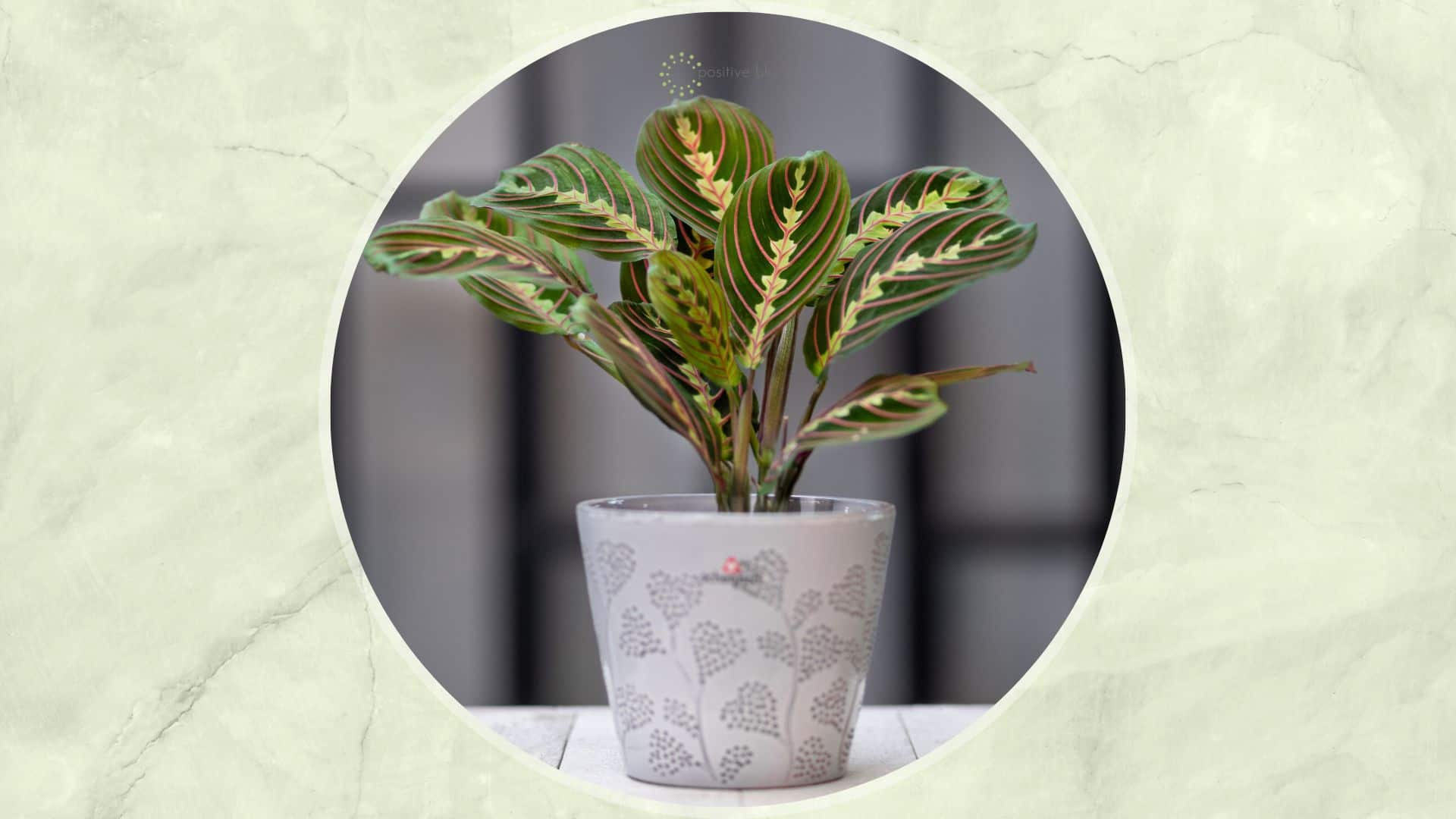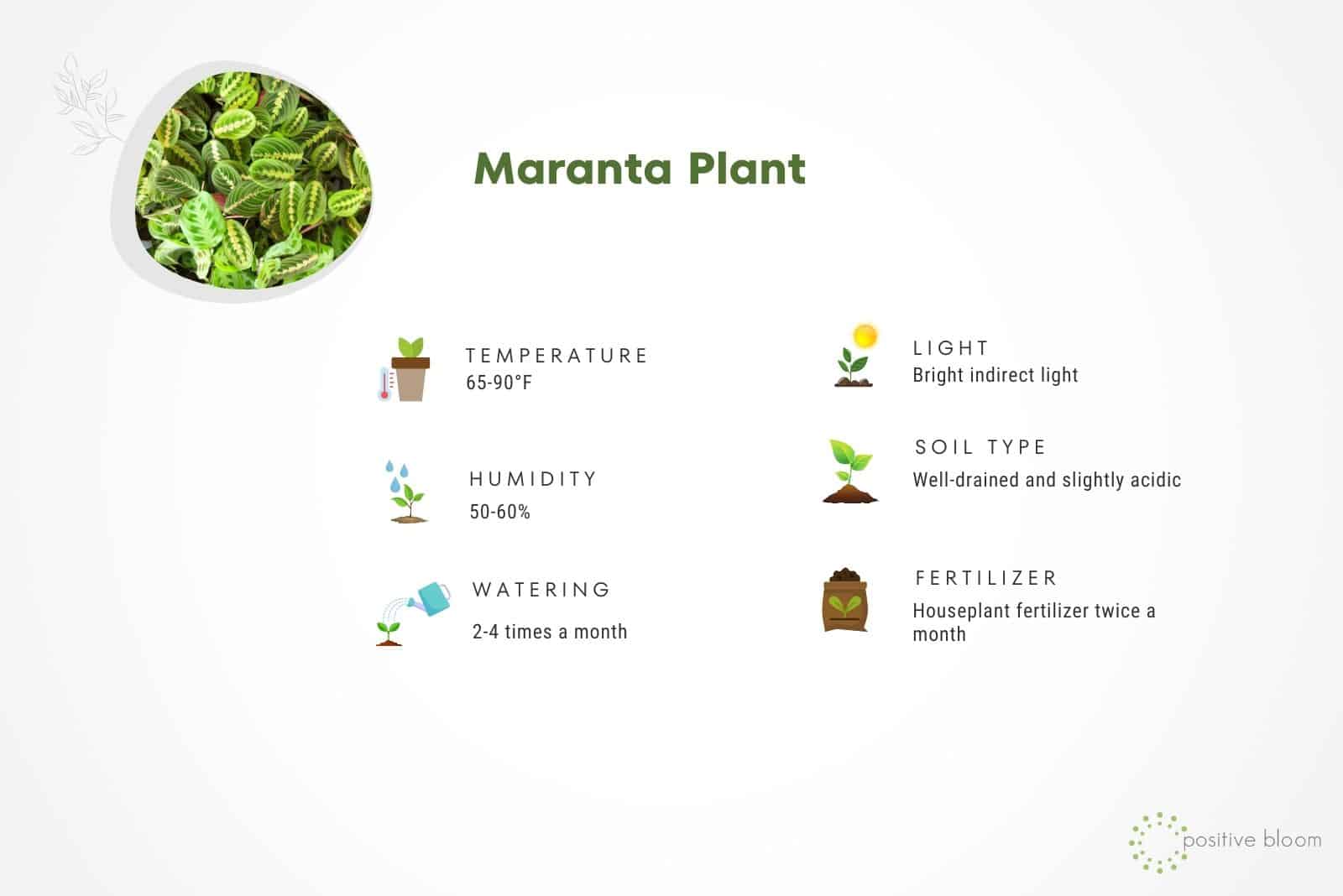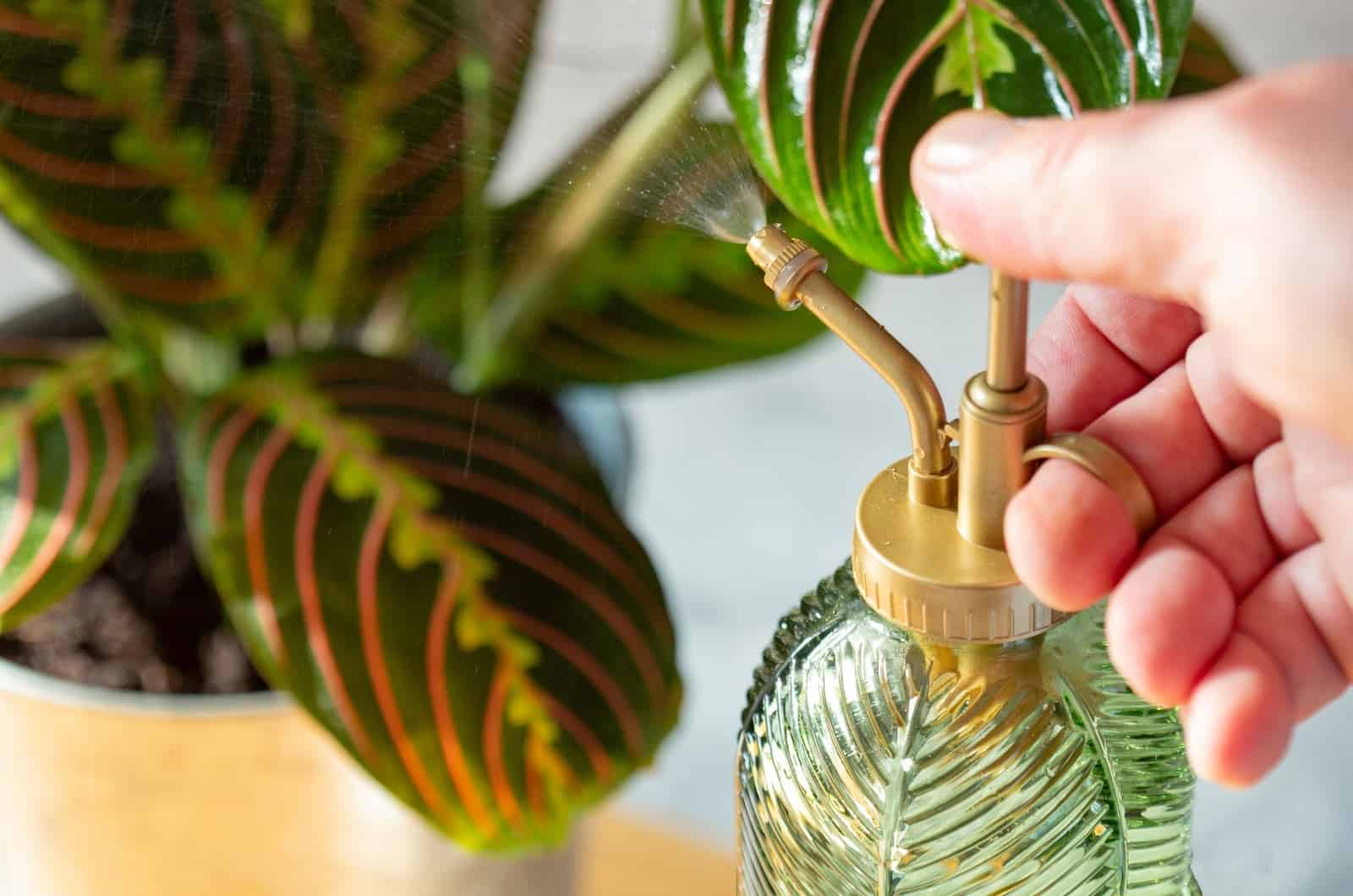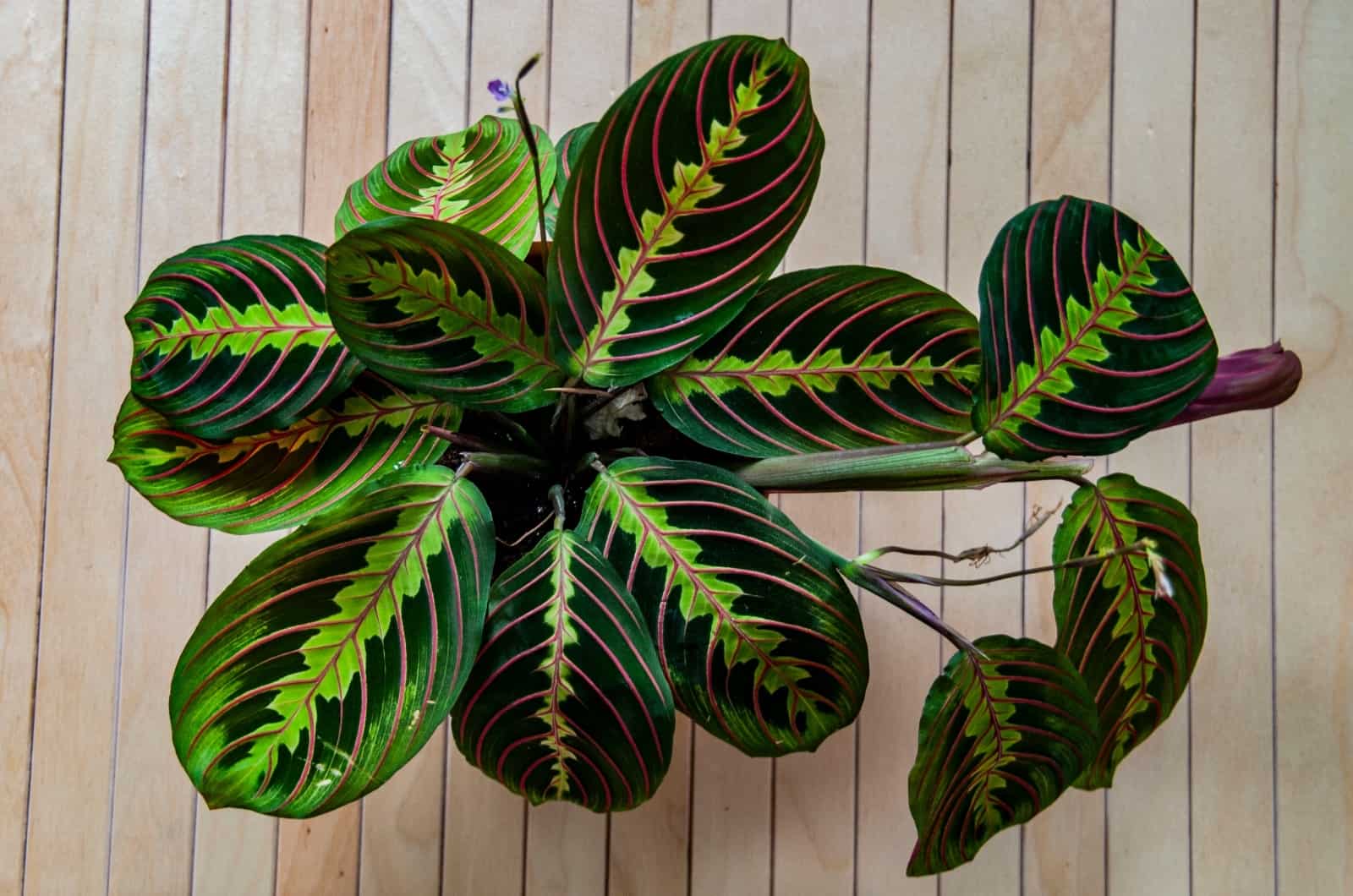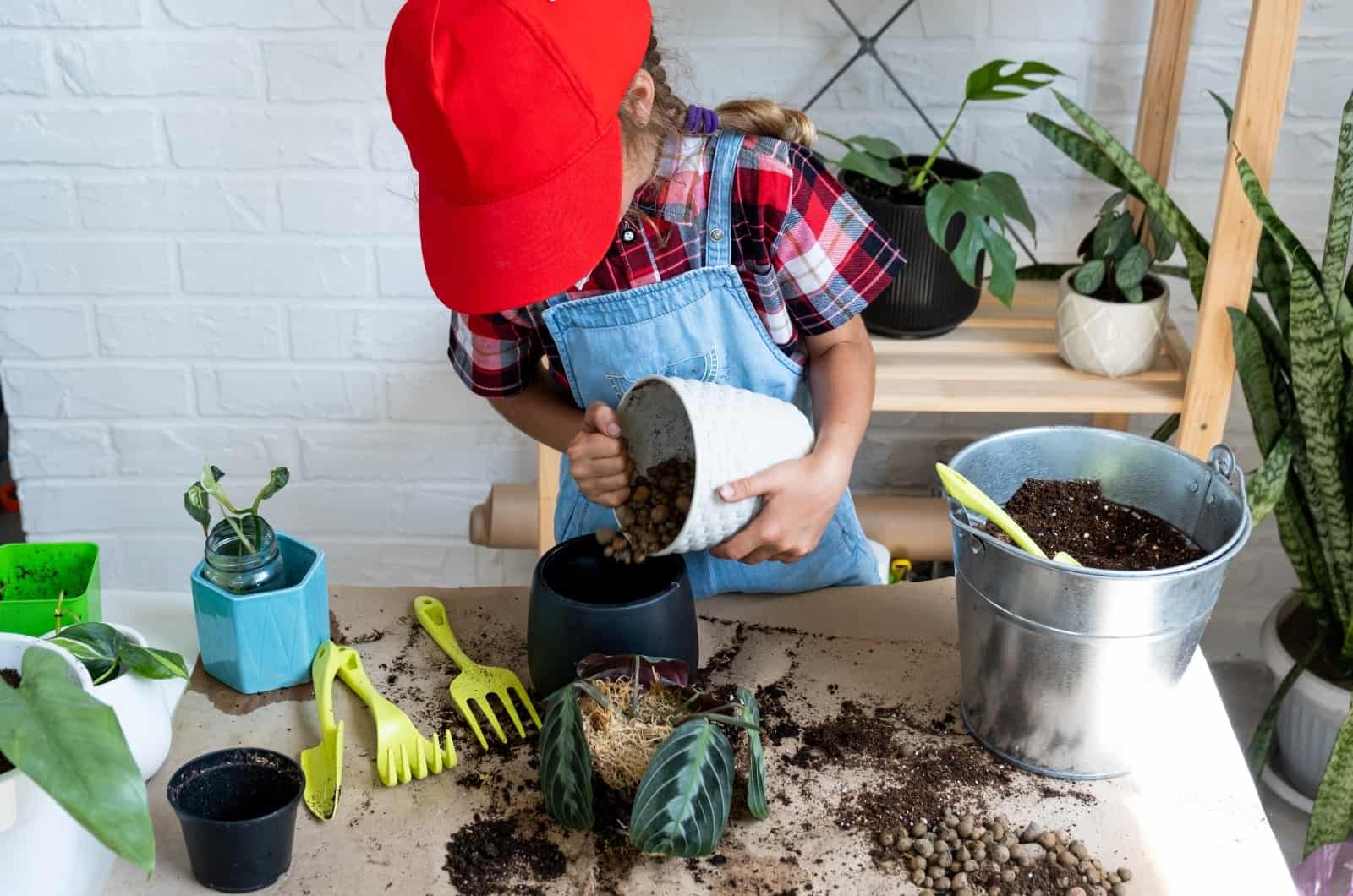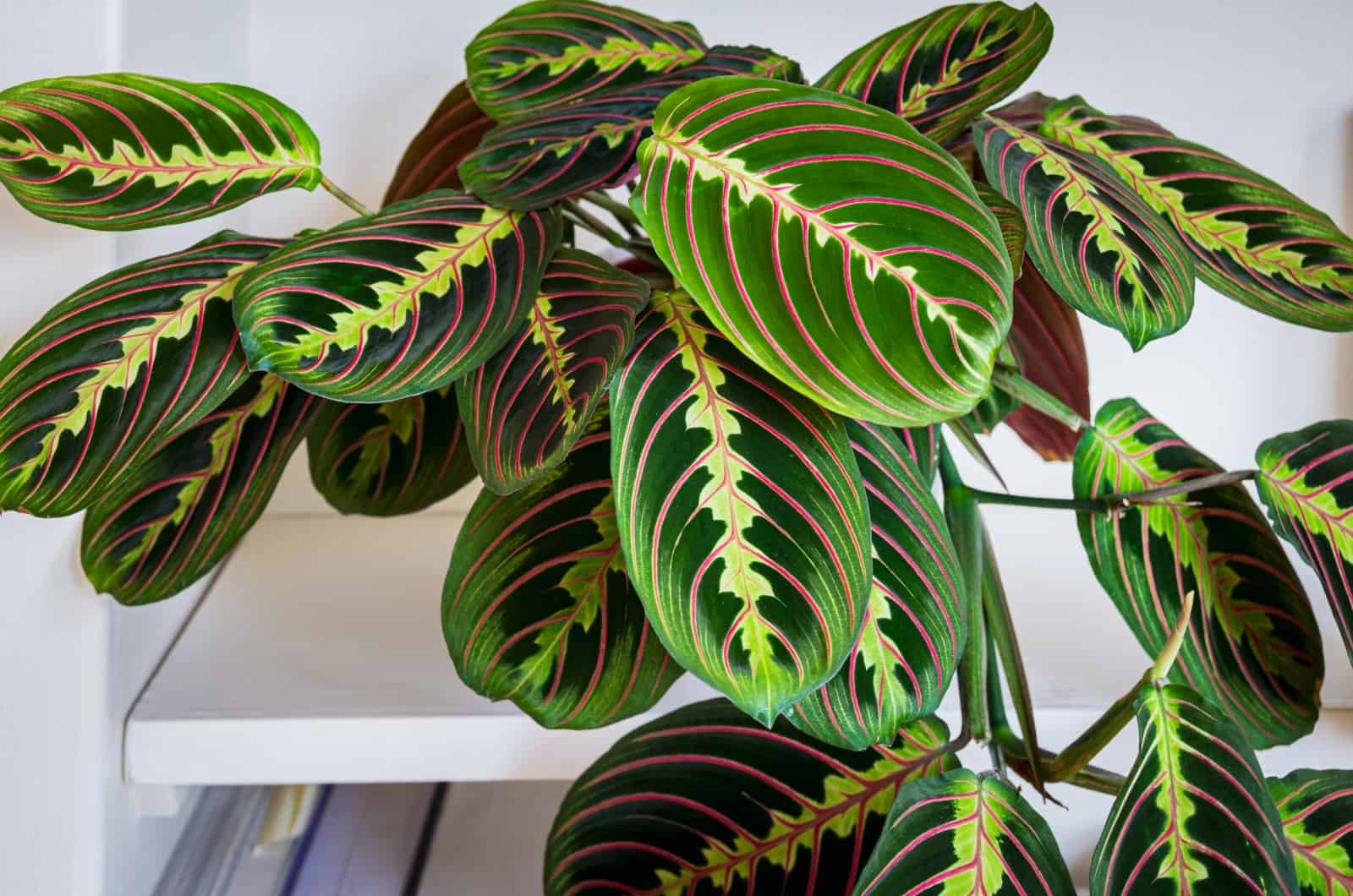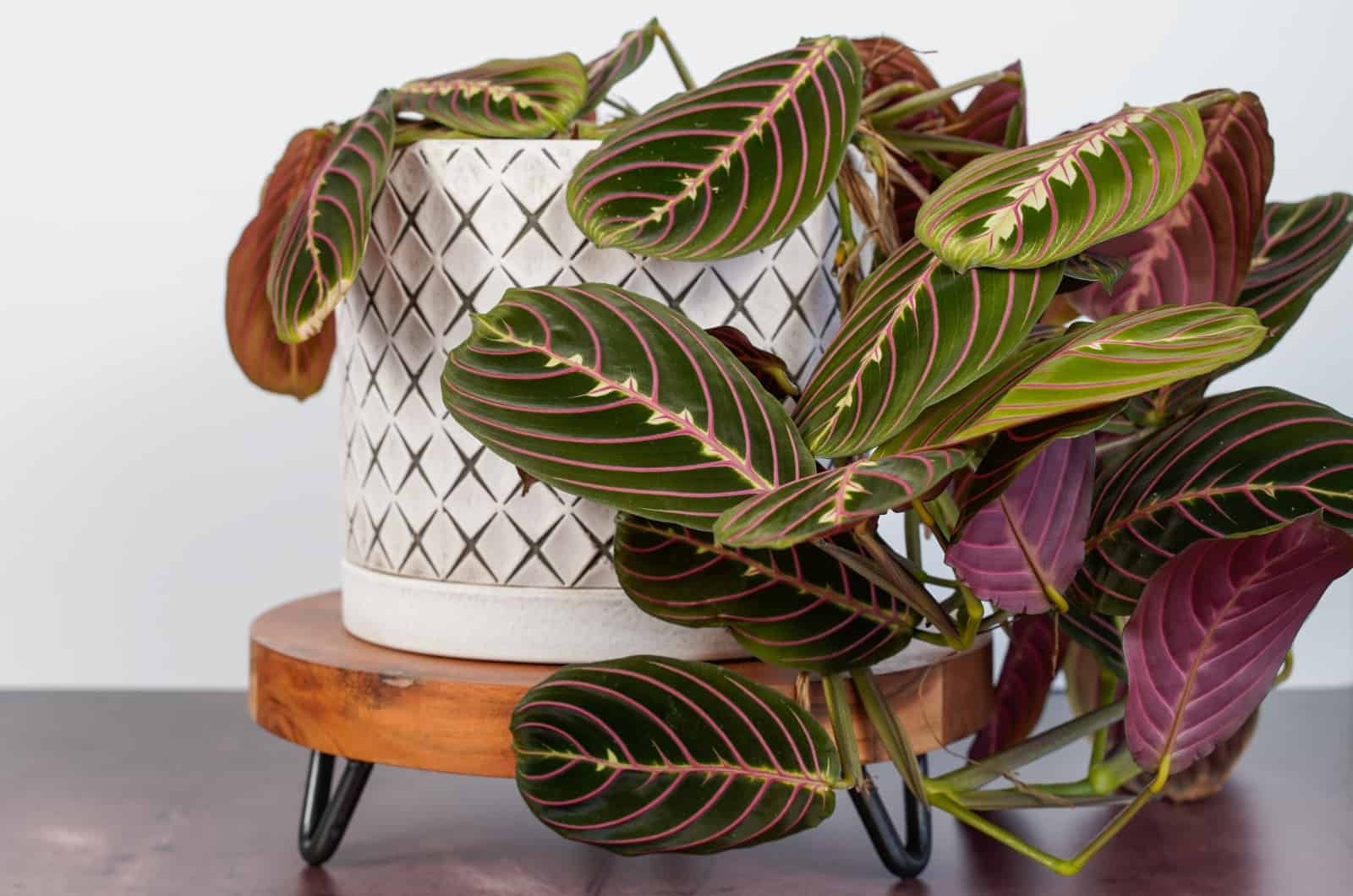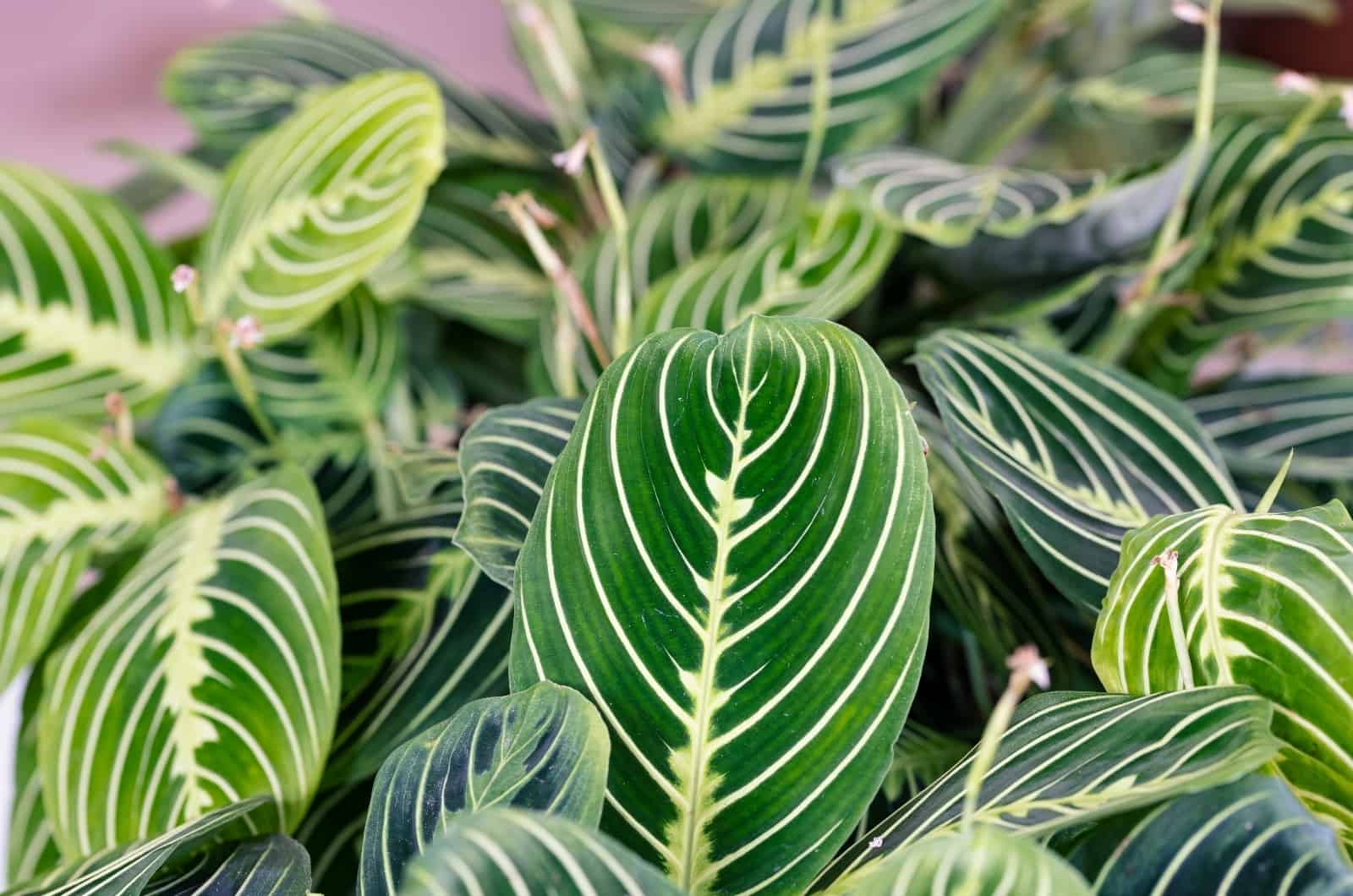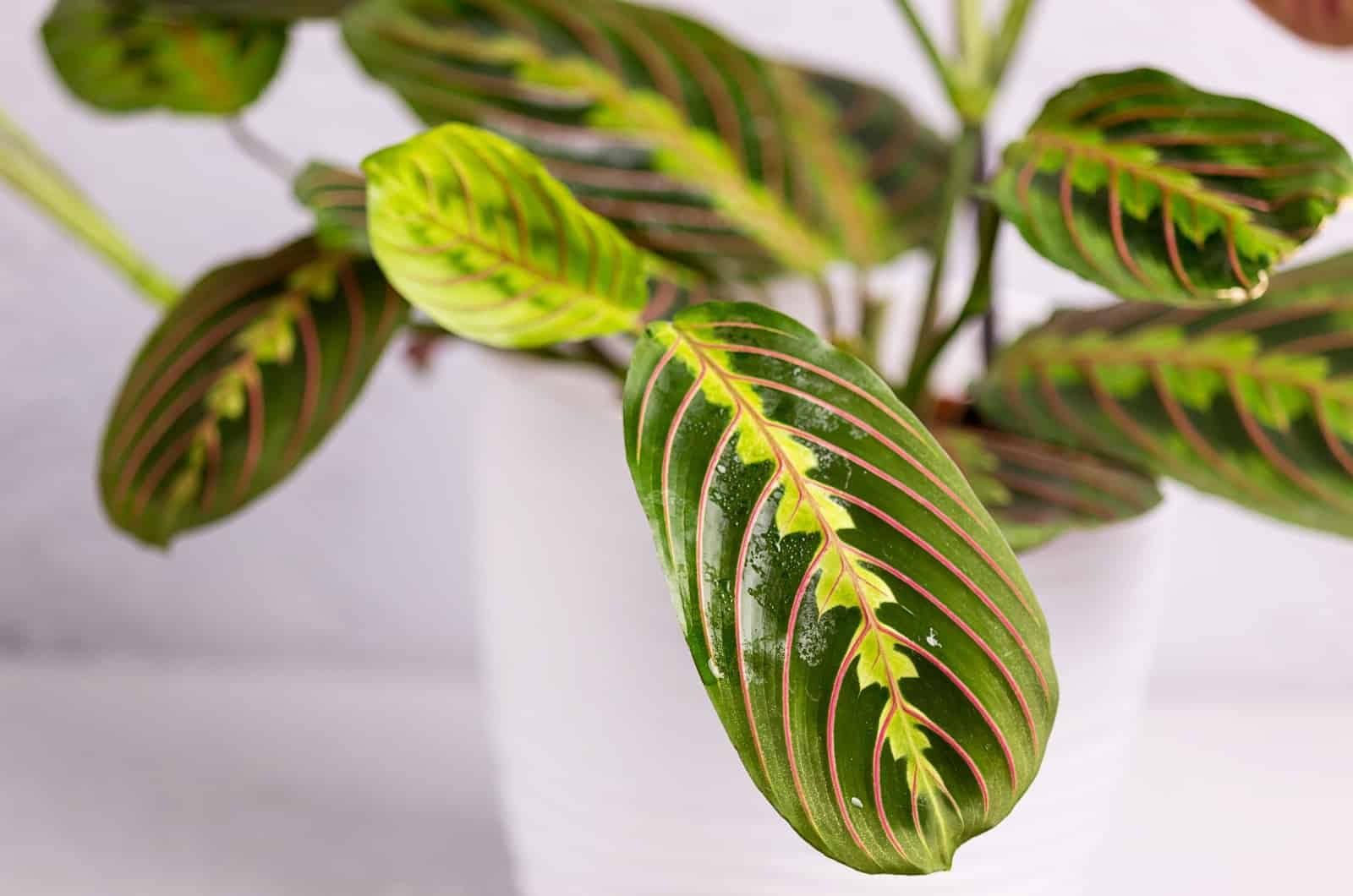Prayer plants are famous for their colorful foliage that’s decorated in a herringbone pattern on a dark green surface. Their red veins and light green middle make these species irresistible for growers all over the world.
But what makes them truly amazing is their easy-care requirements and the fact that you don’t have to tend to them as much as you’d think.
Although, there is one huge problem: which prayer plant to choose – Calathea, maranta, goeppertia, or stromanthe?
Today, we’ll discuss all the things you need to know about maranta, one of the most famous prayer plant genera.
It needs indirect light, a bit of moisture, and a well-draining potting soil to flourish. However, unpredictable things can happen, and your gorgeous plant can succumb to pests, diseases, leaf discoloration, and deformations.
Therefore, we included some troubleshooting tips that will get your prayer plant up and running again in no time.
Finally, we will present some amazing species to help you decide which one to get.
Before we tackle all these issues, let’s learn some basics about this plant:
[table id=643 /]
Maranta Plant Care
Maranta plants are known as the real prayer plants, and can improve the appearance of your interior tremendously.
However, you do have to tend to them properly in order to keep them healthy and beautiful.
Luckily, prayer plant care, whether you own a calathea, goeppertia, or any other species, is rather simple; just expose your green buddy to indirect sunlight and warm temperatures, plant it in a loose and well-drained substrate, and water it occasionally.
And if you want your plant to grow fast and vigorously, you can fertilize it from time to time, repot it every couple of years, and remove dying foliage.
We’ll discuss all these topics, and even bring you a tip or two on their propagation, so that you can nurture healthy plants and enjoy them for many years to come.
Light Requirements
These prayer plants require plenty of light, but you shouldn’t expose them to too much direct sunlight as it can burn their beautiful foliage. Instead, place them in a location with bright indirect light to keep them healthy.
Also, you can find this plant on the list of east-facing window plants, which means you can grow it on eastern and southern windowsills.
Your colorful friend will get direct sun in the morning and afternoon, but this light isn’t that harsh and won’t endanger your plant or cause sunburns.
If you only have north-facing window sills, you should consider using grow lights to supplement the lack of sunlight.
And if you really like the look of this houseplant in the western part of your home, make sure to place it 2-3 feet away from the windows or close the curtains to filter the harsh midday sunlight.
Water And Humidity
This prayer plant loves moisture, but that doesn’t mean you should water it every day.
The general rule of thumb is to irrigate your maranta once a week because the potting mix will have enough time to dry out and prevent waterlogging. Subsequently, this will introduce oxygen to your indoor buddy and it won’t get rotting roots.
Of course, once temperatures get colder and your colorful buddy becomes dormant, you should reduce watering to twice a month.
When watering your prayer plant, make sure to use filtered water as it doesn’t contain compounds such as chlorine and fluoride, which may cause build-up and prevent proper absorption of moisture and nutrients.
You can also use rainwater as it doesn’t contain these minerals. If you only have access to tap water, you can use it, but leave it in the air overnight for the chlorine to evaporate.
Finally, irrigate your maranta prayer plant in the morning or later in the afternoon to keep it properly hydrated without risking water-clogging.
Humidity
Prayer plants come from the tropical forests of South and Central America, which means that they got used to living in high-humidity environments.
Therefore, you should mimic those conditions to provide them with the best possible care, and ensure that your indoor air moisture level is at least 50-60%.
Since average household humidity is around 30-40%, you should raise it a bit to create the perfect living area for your prayer plant.
You can increase indoor air moisture by occasionally misting your plants or by using a humidifier. Moving your plant to the most humid room in your home may also work (just keep in mind the preferred air moisture levels).
Finally, some growers advise using pebble trays or grouping plants together, but these methods aren’t as effective as the others.
For instance, pebble/gravel trays can increase the air moisture up to 7% (at most), which isn’t enough if your indoor humidity level is around 30%.
Temperature
Maranta plants thrive at room temperature and can put on new growth in temperatures between 65-85°F.
That said, they will tolerate conditions up to 90°F, but anything above that can seriously stress out your plant and it won’t be able to develop properly.
When it comes to colder conditions, this plant can survive in temperatures as low as 40°F. However, you won’t see much growth once the conditions drop below 60°F, so try to always keep your indoor temperature above that number.
You should also place your prayer plant away from drafty areas such as near old windows, AC vents, heaters, doors, hallways, and all other locations that experience sudden temperature fluctuations.
Such temperature stress can cause your prayer plant to droop and harm its overall health.
Soil And Fertilizer
The best potting mix for a maranta prayer plant is well-draining and slightly acidic with a pH about 6.0.
You can get a high-quality soil blend in your local nursery or gardening center, or you can make your own. Simply mix two parts peat moss (or coco coir if you want a more eco-friendly option) with 1 part perlite and 1 part potting soil (preferably a loamy and loose one).
And if you’re making your own potting soil for this plant, you can add some worm castings to the blend to make it more fertile and prolong the need for feeding.
Fertilizer
Feed your prayer plants twice a month during their growing season with a regular houseplant fertilizer.
The best plant food is a water-soluble one as you can dilute it to prevent fertilizer burn. However, don’t dissolve it in too much water or the solution would be too weak and not introduce the proper amount of nutrients your plant needs to grow vigorously.
Once the winter comes, you should reduce the frequency of fertilization or stop doing it at all to prevent overfertilization and root burn.
Furthermore, be careful about fertilization if you’ve just repotted your plant. Many store-bought potting mediums contain added nutrients that can last for up to six months, so feeding your plant any more would lead to fertilizer burn.
You can also add some organic matter to your plant before potting it to reduce the need for fertilization.
Remember, the main difference between compost and fertilizer is that the former adds minerals to the soil and improves its drainage and water retention, while the latter just increases the nutrient content.
Repotting
The good news about this species is that you don’t need to replant it frequently. However, you should move it to a larger planter when you see its roots poking out of the drainage holes (which usually happens around every 2 years).
If you don’t repot this houseplant every once in a while, it will become too rootbound and it won’t be able to uptake water and minerals effectively.
The best time to move your indoor buddy to a new planter is during its growing season so that it can continue to grow and develop before it hits dormancy.
Repotting it during this time will also alleviate the effects of transplant shock, which all plants must go through.
When repotting, choose a plant pot that’s 1-2 sizes bigger than the former and ensure it has at least one drainage hole to prevent waterlogging. Make sure that the pot isn’t too deep since these prayer plants don’t have deep root systems.
Once you’ve covered all this, it’s time to replant your maranta. First, take it out of its planter and, if it’s too rootbound, you can separate its roots a bit (if not, just leave the potting mix and the roots in peace).
Then, place some substrate in the bottom of the new container, put your plant in it, and fill the container with the potting mix.
Water your plant until the excess moisture starts to seep through the drainage holes, and place it back in its usual location.
Pruning
These indoor plants cannot grow so tall that you’d need to prune them in order to control their height.
However, you can trim their foliage 2-3 times a year in order to make them bushier. If you want to give your houseplant a lusher appearance, you should remove the leaves wherever you wish more new growth to appear.
Since you’ll never prune extensive amounts of foliage, you can cut your prayer plant whenever you want to. (And if you take a couple of nodes with the leaves and stems, you can propagate it, but we’ll talk more about it below.)
You should also prune old, diseased, and dying leaves whenever you notice them since they take up space the new and healthy growth could fill.
Cleaning
Prayer plants have large and gorgeous foliage, but there is a downside to their most prominent feature – it attracts dust like crazy.
The dusty layer prevents the plant from photosynthesizing normally, which can affect its growth.
Therefore, you should clean the foliage whenever you notice dust on them. One of the simplest ways to do this is by wiping the leaves with a damp cloth.
You can also spray them with water containing a couple of drops of dish soap, but you will have to wipe them thoroughly to remove all residue.
Some growers even recommend cleaning plant leaves with olive oil because it makes them glossy, but it may also leave a greasy layer the dust would stick to.
How To Propagate A Maranta
You can multiply your prayer plant from cuttings or by root division, and it all depends on your needs and preferences.
For instance, if your plant has become too large for its pot and you don’t feel like buying a new one, you can divide it to get two established plants.
And if you’ve just pruned some leaves and stems, you don’t have to throw them away; save them for propagation!
Propagation By Division
Step 1. Take the plant out of its container and examine its stems. If there are a couple of clumps, you can divide them to get some more new buddies.
Step 2. Slowly start disentangling the roots. If it seems too hard, don’t pull them; simply cut them with sterilized scissors.
Step 3. Pot the separate plants into different planters filled with fresh soil mix, and water them until the excess starts running out through the bottom holes.
Step 4. Take them to a location with indirect sunlight and high humidity, and care for them as you would any other prayer plant.
Propagation By Stem Cuttings
Step 1. Take healthy cuttings just below the node.
Step 2. Place the cuttings in water and expose them to bright indirect light.
Step 3. Replace the liquid every couple of days or whenever it becomes dim to ensure proper root development.
Step 4. Once the root system appears, wait a bit for it to become stronger. Once the roots stop being translucent, you can move your plant to the potting mix.
Pro tip: You can also multiply your prayer plant in the potting soil. Simply place the cutting in a seed-starting mix and bright light, put a plastic bag or some other cover over it to increase humidity, and ensure there’s consistent moisture in the medium.
Here are a couple of more tips for multiplying maranta:
Common Issues With Prayer Plants
Marantas are gorgeous plants, and if we want to keep them that way and free from any trouble, including unsightly foliage, diseases, and pests, we need to provide them with excellent care.
But if something goes wrong and your plant exhibits leaf discoloration, starts to droop, and becomes infested with bugs, read the following paragraphs to learn how to deal with these issues.
Pests
The usual pests which invade this plant include aphids, mealybugs and root mealybugs, whiteflies, thrips, etc.
The good news is that you can easily remove them with horticultural oils (such as neem oil) or similar pesticides. The bad news is that neem oil can burn the plant’s leaves if you don’t follow the instructions on the label, so be careful about that.
The key thing is to react as soon as you notice the infestation so that it doesn’t become larger and spread to your other plants, causing more damage.
Diseases
Root rot is one of the most common fungal infections that afflicts this plant, and the cause is overwatering.
Water your plant according to its care guide, and you’ll have no problem with this issue.
But if you notice yellowing of the foliage, droopiness, lack of growth, and an unpleasant smell spreading from the pot, you should examine the plant’s roots and remove the dark and soft ones because they’re infected with root rot.
Afterwards, you can spray some fungicide to prevent the disease from coming back so soon, and then pot your plant into a clean or new container filled with fresh substrate.
Leaf Discoloration
If you notice that your plant’s leaves are pale and turning yellow, you should gradually move it to a brighter location because it’s not getting enough sunlight.
Yellow leaves can also mean that your prayer plant needs more nitrogen, so don’t forget to fertilize it or at least repot it more frequently.
Sometimes, drying of the foliage and a change of color can be a response to repotting, and if you’ve done that recently, don’t fret – your plant will adjust in no time.
Finally, if you notice yellow parts with a brown center that becomes darker and darker, it is a sign that your plant is exposed to too much direct sunlight, so you should move it to a location with indirect light (which won’t burn it).
Curly Foliage
The most common causes of prayer plant leaves curling are cold temperatures and low humidity caused by constant air circulation.
Luckily, this stress is not irreversible, and you can help your plant by maintaining temperatures between 65-85°F or moving it to a location protected from drafts.
That’s why it’s important to keep your plants away from old windows, heaters, AC, etc.
Droopiness
There are many reasons that prayer plants droop, such as inadequate watering, lighting, fertilization, temperatures, or the fact that your plant is rootbound.
Therefore, try to look for other signs as well. For instance, if your plant droops and the leaves curl or the tips become brown, it needs more humidity.
If the droopiness is accompanied by yellow leaves, that could signify low light levels, overwatering, and root rot. In that case, check the plant’s location and the soil to gather more information before starting any treatment.
Popular Maranta Types
Lemon Lime maranta – M. leuconeura ‘Lemon Lime’ is a prayer plant cultivar with lime green veins which distinguish it from the classical red-veined varieties.
Silver Band maranta – M. leuconeura ‘Silver Band’ has a characteristic wide silvery line along the leaf, setting it apart from other species.
Black maranta – M. leuconeura massangeana features black patterns and lacks red ribs.
Red Maranta – M. leuconeura var. erythroneura has that classical prayer plant appearance with red veins across the leaf and light green patterns down the midrib.
Variegated maranta – M. leuconeura var. kerchoveana also comes in a non-variegated version and has dark green patterns along the midrib. The variegated version also features splashes of light green and creamy color.
FAQ
Is the maranta toxic?
The maranta prayer plant is a non-toxic variant that won’t do any harm to your children or pets.
Therefore, you can place it wherever you want and admire its gorgeous foliage.
How long does the maranta live?
These prayer plants are perennials and have a lifespan of 3-5 years before they start waning.
However, you can continue propagating your plants over and over again, and it will feel like you’ve had them forever.
What is special about prayer plants?
The prayer plant at night folds its leaves, which look like praying hands, hence their name. In the morning, the foliage unfurls and obtains their broad shape once again.
Another interesting fact about this plant is that it can filter certain toxins from air according to the NASA clean air study.
However, you will have to get quite a few plants in order for them to completely purify the air. But having just one plant can bring nature indoors (and spending time in nature is proven to have positive effects on our mental health).
Final Thoughts
Maranta prayer plants are easy-to-care for, and you simply need to ensure they get indirect light, a well-draining substrate, room temperatures, and something to drink once a week.
And if you want to elevate your gardening skills to another level, you should implement pruning, cleaning, fertilizing, and repotting into your plant care routine.
Once you do all this, you won’t have to deal with leaf discolorations and deformations, droopiness, pests, or diseases.
But if that does happen, you can just scroll back up to our article and find out how to deal with all these issues.
Finally, we presented some of the most popular maranta houseplants you can get if you want a new friend for the one you already have.
Until next time!

